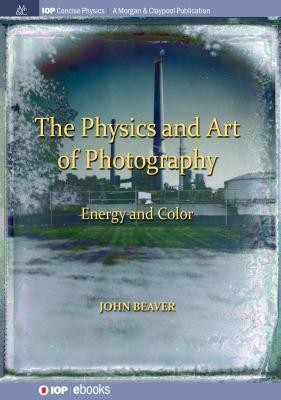
- We will send in 10–14 business days.
- Author: John Beaver
- Publisher: IOP Concise Physics
- ISBN-10: 1643273450
- ISBN-13: 9781643273457
- Format: 17.8 x 25.4 x 1.1 cm, hardcover
- Language: English
- SAVE -10% with code: EXTRA
Reviews
Description
This book uses art photography as a point of departure for learning about physics, while also using physics as a point of departure for asking fundamental questions about the nature of photography as an art. Although not a how-to manual, the topics center around hands-on applications, sometimes illustrated by photographic processes that are inexpensive and easily accessible to students (including a versatile new process developed by the author, and first described in print in this series). A central theme is the connection between the physical interaction of light and matter on the one hand, and the artistry of the photographic processes and their results on the other. One half of Energy and Color focuses on the physics of energy, power, illuminance, and intensity of light, and how these relate to the photographic exposure, including a detailed example that follows the emission of light from the sun all the way through to the formation of the image in the camera. These concepts are described in both their traditional manner, but also using very-low sensitivity photography as an example, which brings the physical concepts to the fore in a visible way, whereas they are often hidden with ordinary high-speed photographic detectors.
Energy and Color also considers color in terms of the spectrum of light, how it interacts with the subject, and how the camera's light detector interacts with the image focused upon it. But of equal concern is the only partially-understood and sometimes unexpected ways in which the human eye/brain interprets this spectral stimulus as color. The volume covers basic photographic subjects such as shutter, aperture, ISO, metering and exposure value, but also given their relations to the larger themes of the book less familiar topics such as the Jones-Condit equation, Lambertian versus isotropic reflections, reflection and response curves, and the opponent-process model of color perception. Although written at a beginning undergraduate level, the topics are chosen for their role in a more general discussion of the relation between science and art that is of interest to readers of all backgrounds and levels of expertise.
EXTRA 10 % discount with code: EXTRA
The promotion ends in 20d.11:00:12
The discount code is valid when purchasing from 10 €. Discounts do not stack.
- Author: John Beaver
- Publisher: IOP Concise Physics
- ISBN-10: 1643273450
- ISBN-13: 9781643273457
- Format: 17.8 x 25.4 x 1.1 cm, hardcover
- Language: English English
This book uses art photography as a point of departure for learning about physics, while also using physics as a point of departure for asking fundamental questions about the nature of photography as an art. Although not a how-to manual, the topics center around hands-on applications, sometimes illustrated by photographic processes that are inexpensive and easily accessible to students (including a versatile new process developed by the author, and first described in print in this series). A central theme is the connection between the physical interaction of light and matter on the one hand, and the artistry of the photographic processes and their results on the other. One half of Energy and Color focuses on the physics of energy, power, illuminance, and intensity of light, and how these relate to the photographic exposure, including a detailed example that follows the emission of light from the sun all the way through to the formation of the image in the camera. These concepts are described in both their traditional manner, but also using very-low sensitivity photography as an example, which brings the physical concepts to the fore in a visible way, whereas they are often hidden with ordinary high-speed photographic detectors.
Energy and Color also considers color in terms of the spectrum of light, how it interacts with the subject, and how the camera's light detector interacts with the image focused upon it. But of equal concern is the only partially-understood and sometimes unexpected ways in which the human eye/brain interprets this spectral stimulus as color. The volume covers basic photographic subjects such as shutter, aperture, ISO, metering and exposure value, but also given their relations to the larger themes of the book less familiar topics such as the Jones-Condit equation, Lambertian versus isotropic reflections, reflection and response curves, and the opponent-process model of color perception. Although written at a beginning undergraduate level, the topics are chosen for their role in a more general discussion of the relation between science and art that is of interest to readers of all backgrounds and levels of expertise.


Reviews